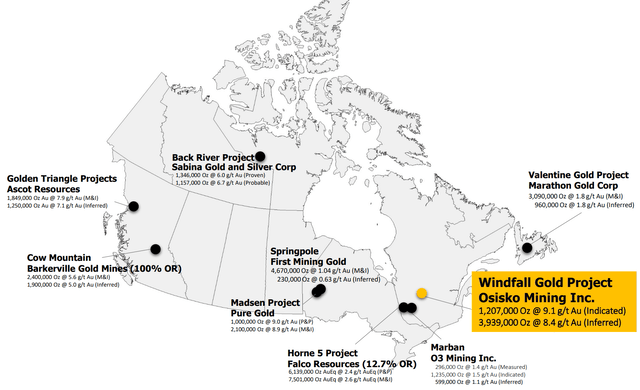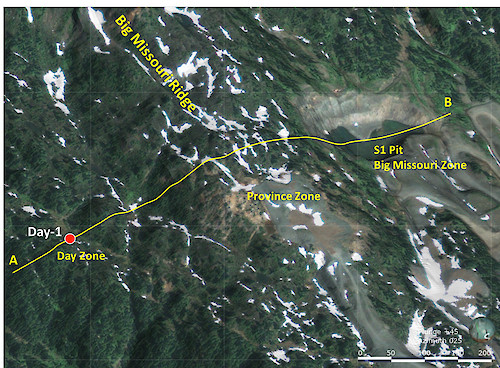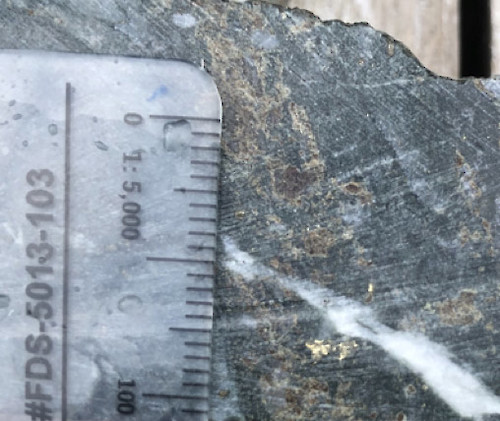 Ascot Resources Ltd (TSX: AOT)
Ascot Resources Ltd (TSX: AOT)
Announced the discovery of new high-grade gold mineralisation at the “Day Zone” at the Company’s Premier Gold Project.
The high-grade intercepts are located 300 m west from the planned underground development at Big Missouri, mineralisation is open along strike to the north and the south. The Day Zone is located on the Big Missouri Ridge, approximately 5 kilometres north of the Premier Mill.
.
.
.
.
.

.
.
Vancouver, B.C. September 14, 2020 — Ascot Resources Ltd (TSX: AOT; OTCQX: AOTVF) (“Ascot” or the “Company”) is pleased to announce the discovery of new high-grade gold mineralisation at the “Day Zone” at the Company’s Premier Gold Project (“PGP”). The high-grade intercepts are located 300m west from the planned underground development at Big Missouri (see Figure 2). Mineralisation is open along strike to the north and the south. The Day Zone is located on the Big Missouri Ridge, approximately 5 kilometres north of the Premier Mill. Additionally, an update is provided on Premier West.
,
Highlights from the Day Zone include:
- 20.62g/t Au over 4.10m in hole P20-2212
- 54.60g/t Au over 2.05m in hole P20-2213
As weather conditions improved in August, exploration was shifted to higher elevation targets at the Big Missouri Ridge after initial drilling was completed at Premier West. This news release summarises the results from three drill holes (for a total of 715 m) at the Day Zone at Big Missouri and seven drill holes (2,183 m) from Premier West.
,
Derek White, President and CEO of Ascot commented, “We are excited about the discovery of another strategically located high-grade zone that could be transformative for Ascot. The new drilling referred to as the Day Zone is west of our known resources at the Big Missouri deposit and is within striking distance of our planned underground development. The Day Zone consists of quartz breccia hosted high-grade mineralisation similar to Big Missouri. Additional drilling will have to be conducted to show continuity between the Day Zone and Big Missouri. We also completed additional drill holes at Premier West which improved our understanding of the orientation and boundary of the high-grade mineralisation there. We are awaiting results from higher elevation drilling at Silver Hill and are commencing additional drilling at lower elevation targets such as Woodbine.”
,
Day Zone
Exploration drilling at the Day Zone was prompted by anomalous soil geochemistry on the west side of the Big Missouri Ridge (see Figure 1) and sporadic drilling from the 1980s that indicated the presence of quartz breccia with associated gold mineralisation. Drill pad Day-1 was established below the top of the ridge in order to test as much vertical extent as possible. A total of six drill holes were completed from this pad and results from the first three holes are listed in Table 1 (assays are pending for the three other holes).
All three drill holes intercepted gold mineralisation at two different elevations with the best intercepts exceeding historical results in this area. These intercepts occur at a depth that appears to be equivalent to the well-established Big Missouri zone on the east side of the ridge (see Figure 2). The first two holes (2212 and 2213) intercepted impressive grades with visible gold in hole 2213 (see Figure 3). The drill core indicates that the area may be affected by structures that offset mineralisation and possibly rotated structural blocks which may account for the different orientation compared to what is known from the eastern side of the ridge where mineralisation dips gently to the west. Figure 2 shows a 300 m gap between the Day Zone and the planned underground development at Big Missouri. Additional drilling will be necessary and is currently being planned to explore this area as well as the northern and southern strike extent of the high-grade zone. The potential for additional resources in this area appears to be very high.
.
Table 1 Summary of exploration drill results from the Day Zone
.
| Hole # | pad | azimuth/dip | From (m) | To
(m) |
Width
(m) |
Au (g/t) |
Ag (g/t) |
| P20-2212 | Day-1 | 260/-45 | 25.95 | 27.10 | 1.15 | 1.71 | 5.9 |
| and | 42.25 | 44.25 | 2.00 | 6.97 | 9.1 | ||
| and | 148.50 | 149.50 | 1.00 | 3.84 | 11.5 | ||
| and | 154.90 | 159.00 | 4.10 | 20.62 | 7.9 | ||
| and | 165.05 | 169.00 | 3.95 | 2.70 | 4.8 | ||
| P20-2213 | Day-1 | 260/-52 | 34.15 | 36.15 | 2.00 | 2.68 | 4.0 |
| and | 151.50 | 153.55 | 2.05 | 1.11 | 6.1 | ||
| and | 155.70 | 157.30 | 1.60 | 1.12 | 6.8 | ||
| and | 161.45 | 163.50 | 2.05 | 54.60 | 29.3 | ||
| and | 167.80 | 169.80 | 2.00 | 3.14 | 2.6 | ||
| P20-2214 | Day-1 | 260/-75 | 73.60 | 75.20 | 1.60 | 2.08 | 2.5 |
| and | 78.80 | 80.80 | 2.00 | 8.17 | 5.9 | ||
| and | 132.75 | 134.35 | 1.60 | 3.88 | 4.7 |
.
True width is uncertain as there is not enough information about the orientation of mineralisation in this area.
.
Figure 1 Image of the Big Missouri Ridge showing the location of the drill pad Day-1 in relation to the S1 pit. The location of the cross section in Figure 2 is indicated by the yellow line.
.
Figure 2 Image of a north looking cross section through the Big Missouri Ridge. The reported drill holes are located on the western side of the ridge while known resources at Province and Big Missouri occur at two different elevations further to the east. Three additional drill holes have been completed (assays are pending), two of these hole traces are off section, and parallel with hole P20-2213 while the third hole is shown in blue. Additional drilling is required to fully assess the potential of mineralisation and its strike extent to the north and south.
.
.
Figure 3 Image of visible gold grain in drill core from drill hole P20-2213 at a depth of 161.97m down the hole. The gold particle is associated with sphalerite, a zinc sulfide mineral, and quartz stockwork.
.
.
Premier West
The Company reported drill results from drill pad PW-1 at Premier West pictured in news releases on July 29 and August 19. The results reported in those releases indicated the presence of high-grade mineralisation to the west of Premier. The fences of drill holes from the one available drill pad followed the mineralisation to the west by rotating the orientation of the drill holes. The westernmost drill holes suggest that the mineralised zone has a flatter dip than anticipated. The results summarized in Table 2 are believed to be from peripheral material to the established high-grade zone. Follow-up drilling will have to be conducted from a different drill pad that allows for drill holes perpendicular to the zone. The location of the planned drill pad PW-2 (see news release August 19) will have to be moved. Ascot is working to establish an alternative location and is hoping to conduct drilling before the end of the year.

Significant independent Canadian mining projects
.
.
About the company
Ascot Resources is a Canadian mineral development company publicly traded on the Toronto Stock Exchange. Their focus is to re-start the historic Premier gold mine, a mine once named North America’s largest gold mine, located just 25 kilometres from the town of Stewart, in northwestern British Columbia in a prolific area known as the Golden Triangle.
In January 2020, the Company announced high-grade resources sufficient to complete a feasibility study on the resumption of mining and milling operations at Premier. The project would substantially benefit from the 100% owned mill and related infrastructure remaining at the Premier mine site.
The Company is rapidly advancing the feasibility study and permit amendments necessary for project approval. In addition, the Company will continue to drill a number of gold-silver discoveries on its 25,000 hectares of mineral concessions that benefit from their proximity to Premier and the towns of Stewart, B.C and Hyder, Alaska.
.
.
Andrew@city-investors-circle.com
.














